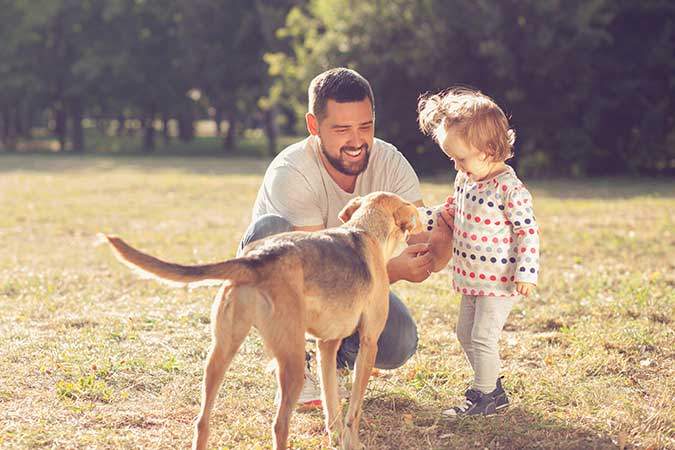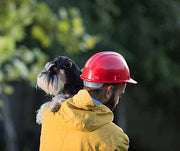Dog Safety for Kids

Dogs and kids go together like peanut butter and jelly! Both are energetic, excitable, and love to play, making them great companions for each other. However, this can also lead to problems, especially if one or both parties get a little too wild. From family dogs to strange dogs, we're going to go over dog safety tips so that young ones will be able to feel calm and confident around their canine friends, as well as learn to respect their boundaries.
First, it's important to point out that all dogs are capable of biting. In fact, according to thefamilydog.com, 77% of dog bites come from a family or friend's dog rather than a strange dog. They are often a result of a dog trying to protect itself if he's feeling overwhelmed or threatened, even if he's not experiencing a real threat. Many times, after a dog has bitten and injured someone, especially a child, they are then abandoned or taken to a shelter. This can be prevented by teaching your child how to safely interact with dogs.

Family Dogs
Whether you've just adopted a dog into your family or you're welcoming a new baby and you're not sure how your dog will react, it's important to take time to allow the dog and child to adjust to each other. As a first rule, never leave a baby unattended with a dog, even if it's a dog you know and trust. Dogs, regardless of their size, are stronger than babies and often don't realize this, even if they're trying to be gentle. Plus, babies love to grab and may accidentally aggravate a dog by pulling on their fur, tail, ears, etc.
For older kids, it's important to teach them a few basic "dog manners" not only if you have a new dog in the home, but also so that they can safely interact with others' dogs.
- Boundaries: First and most importantly, teach your child to respect a dog's boundaries. Getting too close or up in a dog's face may make them uncomfortable, as does following or chasing a dog when he doesn't want to play.
- Body Language: Your body language can communicate a lot to a dog, so ensure that you're teaching your child how to show a dog that they are a safe person and not a threat. Avoid direct eye contact when first getting to know a new dog, and keep your hands to your sides.
- Calm Playing: Encourage your child to play calmly with dogs and to be gentle. No chasing, wrestling, tackling, or picking up and carrying the dog. This could lead to your dog being irritated or playing a little too rough.
- Respecting Personal Space: Like the first point, it's important to respect a dog's space and teach young ones to leave dogs alone while they're doing things such as eating or sleeping. Personal space also includes not sticking your hands or fingers in a dog's mouth (or other places they might appreciate being touched) and not cornering a dog. This may make them feel trapped or scared.
Communication is key to keeping both your child and dog happy and safe. Learning to read a dog's body language can be extremely helpful in understanding how your dog is feeling and what he's trying to say to you (more on this in a bit!). It's also helpful for your dog to receive a little bit of training as well. Teaching your dog to obey basic commands will help them learn to listen to you. Socializing your dog is also a great way for him or her to get accustomed to being around other people and dogs. Include your dog in activities and games with your family and friends when you can. And remember, while it's great to have a bit of fun, innocent roughhousing can quickly turn into a biting situation if you're not careful.
Strange Dogs
When it comes to strange or unfamiliar dogs, it's hard to know how they are going to react to children. Dogs who are used to kids may be excited if a child approaches them while dogs who are not used to children may be scared. Even the most well-trained dogs can become frightened if someone new is coming up to pet them. Therefore, it's incredibly important to teach your children how to handle interacting with dogs that they are unfamiliar with.
First, you should always ask an owner for permission to pet their dog. Once you get permission, approach the dog slowly and carefully. Don't run at him or do anything that could scare or excite him. Next, hold out your handle slowly and let the dog sniff or lick your hand before your pet him. This allows the dog to have a chance to "check you out" and will help build some trust.
Another thing to note is that you shouldn't teach your child to fear dogs. While it's important to teach them to use caution, you don't want them to develop a phobia of dogs. This could cause your child to run away at the first sight of a dog, which may excite the dog, causing him to play a game of chase. This might be fun for the dog but will make the situation worse!
Dog's Body Language
Body language, as stated earlier, is important in how you communicate with dogs as well as how dogs communicate with you. Therefore, it's a good idea to learn how to read a dog's body language. Here are a few postures and positions you may see and what they mean:
- Hunched body posture: This is often a sign that a dog is scared or stressed. If you see a dog in this position, give them space and be extra cautious and gentle towards them.
- Weight shifted forward: This can either mean that a dog is curious about something, or it could be a sign of aggression. Watch for other signs such as their fur or tail standing upright and be sure you give this dog plenty of space.
- "Play bow": You've likely seen dogs do this before! This is where a dog will have their front low to the ground while its backside is sticking up in the air. This usually means that the dog is ready to play with you.
- Back turned to you: This means that a dog is relaxed and comfortable around you.
- Rolling on back: This is always a good sign! It means that the dog is fully relaxed and ready for a belly rub!
Conclusion
Dog safety isn't just good for kids to learn – it's good for adults to brush up on as well! The more you're able to understand your dog and the dogs around you, the better your relationship with these furry fellows will be.
Previous article

Next article

Related posts
View all-

5 Simple Tips to Make Sure Your Cat Drinks Enough Water
Ensuring your cat stays hydrated is important, but it can be challenging since many cats don't drink enough water. Dehydration can lead to kidney disease and other health issues. Fortunately, you can encourage your cat to drink more with a few simple changes. Read Article -

How to Keep Your Cat Busy at Night (So You Can Sleep)
For many cat owners, the quest for a good night's sleep while keeping their feline friends content and engaged can seem like a never-ending battle. Cats, naturally more active at night or early in the morning, often disrupt your sleep schedules with nocturnal activity, whether through playful nature or seeking attention. Read Article -

Should You Bathe Your Cat? Everything You Need to Know About Cat Hygiene
When it comes to cat hygiene, a common question among cat owners is, "Should you bathe your cat?" Understanding how to care for felines, especially bathing cats properly, is crucial for maintaining their overall health. Most cats are fastidious groomers, but specific scenarios like long-haired cats getting dirty or skin irritations, might require a bath.
Read Article



